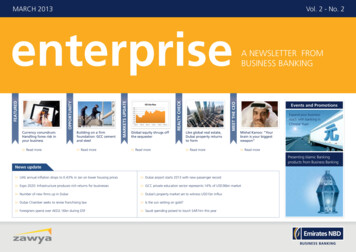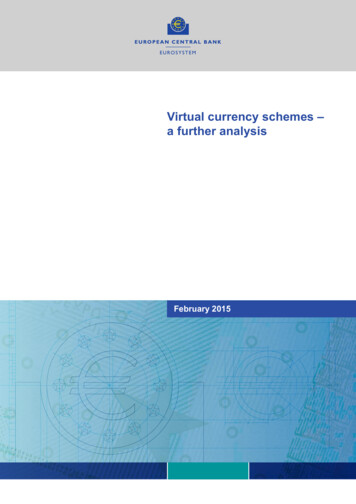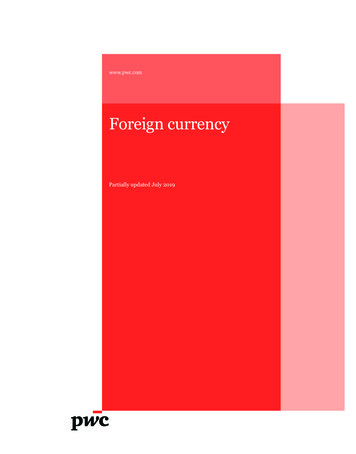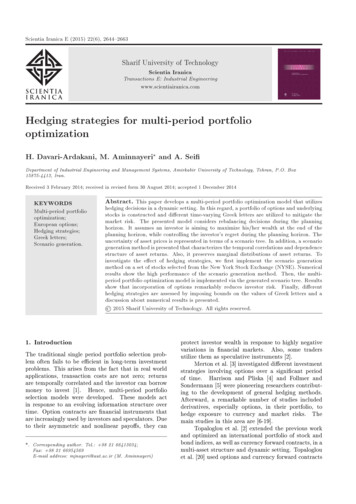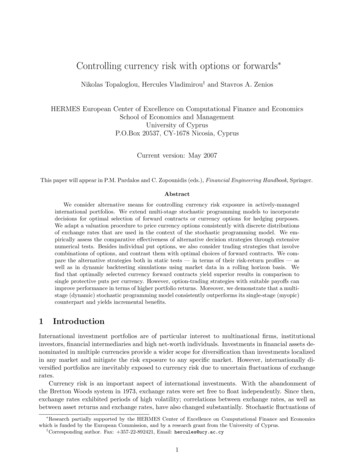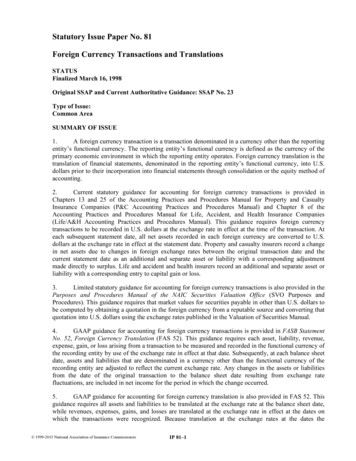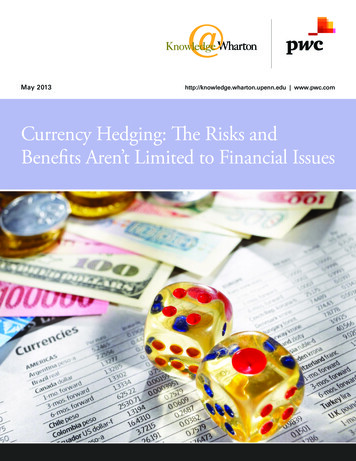
Transcription
May 2013 http://knowledge.wharton.upenn.edu www.pwc.comCurrency Hedging: The Risks andBenefits Aren’t Limited to Financial Issues
Currency Hedging: The Risks and Benefits Aren’t Limited toFinancial IssuesWhen a publicly held company engaged in a multi-billion dollar investment in an overseas locationrecently, the firm considered using a hedge — or swap — contract to reduce the risk that a big currencyswing would impact costs and financial results. The plan was sound financially. Yet, management hadconcerns about the reaction of investors to this approach and decided to drop the hedging plan, saysChris Rhodes, accounting advisory services partner at PricewaterhouseCoopers (PwC).Why? Because the CFO determined that,although the hedge would protect all the cashspent in the foreign jurisdiction against currencyexposure, the cost of capital — in this caseborrowing in external markets — “would benegatively impacted by the inability of someanalysts to understand the reporting issuesinvolved,” Rhodes explains. “The concern is that,although many analysts would immediately graspthe sophisticated currency-hedging proceduresthat were key to the plan, others might not.”“The risks, from political uncertainty, to global fundingflows, to the timing of revenue collections and othertransactional activity, may be difficult to predict.”—Catherine M. SchrandIn this case, at least, the CFO decided shewould accept variability in cash costs rather thanrisk misunderstanding or instability in reportedresults that could potentially disrupt access tocheap debt financing.If management makes the right move but doesn’tcommunicate it properly, the wrong signal maybe sent to the marketplace, Rhodes adds. “It mayseem counter-intuitive at first, but if analysts andinvestors don’t understand what the firm’s doing,PricewaterhouseCoopers LLP Knowledge@Wharton a company’s stock price may suffer even if thehedging actually helps the firm.” So, even thoughhedging itself is a tool — neither intrinsically goodnor bad — “the direct costs and benefits of thestrategy have to be weighed against the impacton investor relations.”Put another way, answering the question “tohedge or not to hedge” is more than a straightforward mathematical decision. “There is nosimple answer,” notes Catherine M. Schrand, aWharton accounting professor. The idea behindcurrency hedging involves reducing or eliminatingrisk, but the cost involved and the ability toachieve the aims needs ongoing consideration.“The risks, from political uncertainty, toglobal funding flows, to the timing of revenuecollections and other transactional activity, maybe difficult to predict.”An increasing volume of cross-border activity,coupled with rising currency volatility, is forcingmany multinational companies (MNCs) to thinkharder about exchange rate exposure and theway that investors react to the use of currencyhedges and other derivatives. For example, arecent press release from the CFA Institute,which oversees the Chartered Financial Analystdesignation, notes that derivatives “are prone toleaving investors with a lack of understanding ofassociated risks and unable to anticipate potentiallosses if they are not disclosed properly.”Currency Hedging: The Risks and Benefits Aren’t Limited to Financial Issues 2
Of course, savvy analysts and investors don’thave a problem understanding sophisticatedhedging and other strategies, but as hedgeuse grows — more than 100 MNCs ranked therisks brought on by currency hedging as theirbiggest concern, ahead, even, of liquidity riskand counter-party risk, according to a July 2012Barclays Bank Plc Global Risk Survey — effortsare being made to ensure that more people havea good grounding in these issues.Stacking the CostsCosts can add up quickly, too. “A company willhave to hire staff to collect information fromsubsidiaries and to crunch data, and to maintainrelations with a variety of brokers and brokerdealers,” Schrand says. “The outlays can quicklybecome a large fixed cost, so bigger firms aregenerally more likely to hedge since they canamortize the costs over a larger base.”And not all of the many issues requiringconsideration relate directly to the economicsof hedging. Another perceived risk, particularlyfor investors, is incentive asymmetry, or at theleast the appearance of it, says Rhodes. “Sayyou represent a pension fund that’s invested in astock. You want management to have a 20-, 30or 40-year time horizon, but what if they appearto have a shorter horizon?”The challenge is that some investors may viewthe short-term nature of hedge programs as onemore example of management’s preoccupationwith short term results, similar to investors’complaints about managers who obsess overquarterly earnings. But the issue is deeper thanthat, Rhodes adds, since the short-term nature ofbudget cycle hedges should be considered in lightof how they fit into a company’s long-term plan.Budget-cycle hedging, for example, is usefulfor managing issues like short-term swings andliquidity that are commonly associated withnear-term planning purposes. But what happenswhen the business design encompassesstructural long-term exposures, such as aPricewaterhouseCoopers LLP Knowledge@Wharton revenue base that’s tied to the euro but also hasfunding sources that are in U.S. dollars?In a case like that, the short-term benefits of thehedge are indeed limited to the maturity of thehedge, but by rolling the hedges, or updatingthem periodically, management also addressesthe long-term exposure issues. That may not beimmediately apparent to outsiders, however, soinvestors will need to understand both the longand short-term profiles, and how managementapproaches each.In fact, Wharton finance professor Wayne Guaythinks that the potential for a misalignment ofmanagerial vs. shareholder incentives is not aslikely now as it once was. In many cases today,most components of management compensationare “stocks and options that vest over a periodof years . Because their portfolio is tied tothe long-term stock price of the company,management is more likely to think long-term,aligning their interests with those of investors.”Walking and Talking the TalkFor many companies, the key operationalconsiderations for hedging include why thecompany is hedging in the first place and howthe transactions relate to the core business,Rhodes says. Other prominent issues includethe profit margin and credit profile. “Some or allof these issues should be part of the decisionmaking process. But it really boils down to twoelements: How good are you at hedging, andhow good are you at explaining it?”Hedging can be the “hinge” that connectshistorical cost accounting with fair valueconcepts, Rhodes says. This idea comes outof accounting regulation ASC 815 (formerlyFAS 133), wherein a change in the marketvalue of any derivative — a hedging instrumentbeing but one example — is offset against thechange in market value of the underlying assetor liability. Typically, those items are carried onthe balance sheet at historical — or acquisition— cost. Changes in the value of the derivativeCurrency Hedging: The Risks and Benefits Aren’t Limited to Financial Issues 3
and underlying instrument then get reported inanother section of the financial statements — inthe earnings statement. So, while hedging offerseconomic benefits, it can also complicate scorekeeping — or financial reporting — particularlyfor publicly held companies that must makeextensive disclosures.There’s “incredible complexity” when it comesto hedging, says Guay. “Often, there’s a tradeoffbetween a company’s efficiency in hedgingand the understanding that’s communicated toinvestors. If the hedging tools are so opaque thatinvestors don’t understand how the firm works,then it may be better in some cases to back offon the use of complex hedging.”“It adds a unique dimension, where a company has todetermine if it can overcome the complexity inherentin the hedging instruments as well as the accountingpresentation, and if the firm can explain it in a way thatoutsiders will understand. You have to know your analystsand how they follow certain elements of your company.”—Henri Levequemake great sense, the strait-jacket of financialreporting may jumble the perceptions amongsome analysts.“Many of them are able to penetrate the noiseand will understand the underlying economics,”says Leveque. “But the ones who don’t will findit difficult to understand the long-term alignmentof the executive suite. So your investor relationsprofessionals must be able to tell a story that laysout the really good analysis that the company didas it navigated a complex financial pathway.”What’s more, it is not simply a matter of gettingthe analyst community to understand long-term,net-positive results. A company may execute “aperfectly good trade with a clear explanation tosupport it,” says Rhodes. But when investors raisequestions about the transaction, managementmay be forced to spend “a significant amountof time” figuring out how to correctly displaythe activity in the financial statements and howto explain it. Although some companies dothis very well, others often “miss the angle” inmanagement’s analysis of hedging transactions.Potential Drag on the Stock PriceThat “introduces another layer to the discussion,expanding it from a numbers-crunching exerciseto an investor relations issue,” notes HenriLeveque, leader of PwC’s U.S. capital marketsand accounting advisory services. “It adds aunique dimension, where a company has todetermine if it can overcome the complexityinherent in the hedging instruments as well asthe accounting presentation, and if the firm canexplain it in a way that outsiders will understand.You have to know your analysts and how theyfollow certain elements of your company.”How should a company make an overallassessment of a potential hedging transaction?One approach, Rhodes suggests, is to adopt a“four box” decision set — similar to a decisiontree — to weigh the pluses and minuses.Imagine a kind of flow chart, where the first“box” poses a “yes” or “no” question thatmust be answered before moving on to thenext box. Each subsequent box also poses aquestion that must be answered before movingto the subsequent box. The entire process — inthis case the decision whether or not to makea hedge — would end if the answer to anyquestion is “no.”Some analysts, for example, tend to makejudgments and issue reports based on a narrowselection of metrics that they’re comfortablewith. He notes, though, that even if the longterm economics and return on equity for a hedge“In box one, a company could determine,based on the specific circumstances, whethera hedge makes economic sense,” he says. If itdoes, the company can move to box two, wheremanagement should “look at whether, on thePricewaterhouseCoopers LLP Knowledge@Wharton Currency Hedging: The Risks and Benefits Aren’t Limited to Financial Issues 4
face of it, hedging may drive negative investorreaction.” If decision-makers decide that hedgingmay make sense after the initial consideration ofanalyst reaction, then the process moves on tobox three, where they may decide that hedgingnot only can make sense but also the companycould either: (1) disregard the level of negativeanalyst and investor reaction; or, (2) disclose thehedging activity with simplified reporting.Finally, in box four, the analysis may concludethat hedging may make sense and managementmay decide to disclose the activity usingsophisticated hedge accounting, and that thecompany will invest the time needed to explainits actions in a way that brings clarity to analystsand investors.“A best-practice approach will generally call formanagement to gain a thorough understandingof the underlying issues before making thedecision to hedge or not to hedge,” saysLeveque. “The four-box decision tree can assistin making that decision, and once managementhas arrived at a conclusion, it’s a matter ofcommunicating the activity to the investmentcommunity. The reason: If analysts or investorsdon’t understand something, their very humanreaction is generally to go negative on it. Andgoing negative is likely to have other realeconomic impacts on this enterprise that franklymay not have been there.”To illustrate the practical effect on a company,consider two companies involved solely in goldmining that have taken fundamentally differentapproaches to earning profits and communicatingtheir business model to the public. One companyforgoes hedging gold and the other hedges thecommodity.The first company fundamentally offers agold price pure-play, says Rhodes. “In effect,management is saying, ‘I control a block ofPricewaterhouseCoopers LLP Knowledge@Wharton mineral rights for extracting gold. The value of thegold in the ground will either go up or down andI accept that risk. I focus only on getting it out ofthe ground efficiently with the right equipmentand the right people.’” If gold goes up, thecompany’s stock will likely go up, and vice versa.The second mining company chooses to hedge.The message here, says Rhodes, “is basicallythat when you buy my stock, you are not buyingthe near-term risk of gold. I hedge againstthe gold that’s in the ground and the price atwhich I sell it. The only thing you’re buying ishow efficiently I can get it out of the ground.”Investors in the first company buy mostly goldrisk “with a little bit of operational risk.” Investorsin the second company are “buying mostlyoperational risk.”It’s a personal choice. Some investors want acompany to retain risk, instead of hedging itout, often because of the potential for a higherreturn. Others may generally favor the industry’sprospects, but prefer to try to lower the risk oflarge swings in value. All of this used to be leftentirely for investors to sort out. But explainingthings in a way that analysts and shareholderswill understand is increasingly important becauseaccounting regulations now call for moretransparency, notes Schrand.“Early on, accounting rules regarding thereporting of derivatives actually increasedvolatility among firms’ reported financial results,”she notes. “That was the exact opposite of whatcompanies hoped to achieve with hedging. Butdevelopments like the comprehensive incomestatement have helped to bring more orderto hedge accounting reporting. There is someevidence, however, that the term ‘derivatives’may cause some concern among investorswho associate it with undue risk; so companiesshould be very careful when they describe theirhedging activities.”Currency Hedging: The Risks and Benefits Aren’t Limited to Financial Issues 5
In fact improved disclosure is “crucial in allowinginvestors to make more informed decisionsand to ensure that company financial reportscommunicate key information regarding riskexposures and risk management more clearly,”notes a recent CFA report, User Perspectivesof Financial Instrument Risk Disclosures UnderIFRS Volume II - Derivatives and HedgingActivities Disclosures.“Decision makers must talk to the CFO, the CEO andthe board, and explain the economics.”—Chris RhodesBest PracticesWhen the rewards from hedging appear to betoo high to pass up, management could investthe time needed to improve on its explanationsof its trades. One potential avenue is throughmeetings or conference calls with analystsand investors, suggests Wharton accountingprofessor Brian Bushee.“It would be best to do it at a time separatefrom regular earnings announcements or otherdisclosures, so that everyone can focus onthe issue and not have it be confounded withPricewaterhouseCoopers LLP Knowledge@Wharton performance numbers or forecasts.” The onlydownside would be “potential proprietary costs ifthis is an open meeting, such as a freely availableconference call or webcast” where “competitorscould potentially listen in and gain competitiveinformation. So perhaps a better venue would bean investor conference, or even a private meeting.”Private meetings are not necessarily forbidden byRegulation FD (Regulation Fair Disclosure). “Aslong as the managers of a publicly held companydo not give out earnings or sales guidance, andjust stick to the details of the hedging strategy,then there would be no problem with a privatemeeting,” Bushee says. “This is becausethe managers are not disclosing privilegedinformation, but are simply filling in the ‘mosaic’of analyst and investor information.”Some clear lessons in all of this are thatdecisions about currency hedging are highlycase-specific and will vary depending on acompany’s individual circumstances. But onbalance, hedging is very complex. “Decisionmakers must talk to the CFO, the CEO and theboard, and explain the economics,” Rhodessays. It also takes a material amount of time toknow how to “correctly display and explain theirstrategy” to analysts. An integral part of that:“You must know your analysts, and how are theyfollowing” complex derivative transactions.Currency Hedging: The Risks and Benefits Aren’t Limited to Financial Issues 6
To have a deeper conversation about how this subjectmay affect your business, please contact:Henri LevequePartner, Capital Markets and Accounting Advisory ServicesUS Practice Leader678.419.3100h.a.leveque@us.pwc.comChad KokengePartner, Capital Markets and Accounting Advisory ServicesAccounting Advisory pher RhodesPartner, Capital Markets and Accounting Advisory Services646.471.5860chris.rhodes@us.pwc.comABOUT KNOWLEDGE@WHARTONKnowledge@Wharton is the online business analysis journal of the Wharton School of the University of Pennsylvania. The site, which is free,captures relevant knowledge generated at Wharton and beyond by offering articles and videos based on research, conferences, speakers,books and interviews with faculty and other experts on current business topics. The Knowledge@Wharton network —including Chinese,Spanish, Portuguese, Indian, Arabic, Israeli and High School editions — has more than 2.2 million subscribers worldwide.For more information: http://knowledge.wharton.upenn.eduTHE WHARTON SCHOOLFounded in 1881 as the first collegiate business school, the Wharton School of the University of Pennsylvania is recognized globally forintellectual leadership and ongoing innovation across every major discipline of business education. With a broad global community and oneof the most published business school faculties, Wharton creates ongoing economic and social value around the world. The School has 5,000undergraduate, MBA, executive MBA, and doctoral students; more than 9,000 annual participants in executive education programs; and apowerful alumni network of 91,000 graduates.PWC’S CAPITAL MARKETS AND ACCOUNTING ADVISORY SERVICESBusinesses today face a myriad of complex issues — related to acquisitions, divestitures, consolidations, bankruptcy, restatements, debt /equity offerings, changes to accounting methods, stock compensation, and more. We help companies maximize value during these momentsof exceptional change. With a global network of credentialed, trusted advisors, we support companies with their accounting, financial reportingneeds. Our practitioners tailor solutions to meet our clients’ needs, allowing for a thorough approach in anticipation of the requirements ofauditors, investors and regulators.ABOUT THE PWC NETWORKPwC firms help organizations and individuals create the value they’re looking for. We’re a network of firms in 158 countries with close to 169,000people who are committed to delivering quality in assurance, tax and advisory services. Tell us what matters to you and find out more by visitingus at www.pwc.com.
PricewaterhouseCoopers LLP Knowledge@Wharton Currency Hedging: The Risks and Benefits Aren't Limited to Financial Issues4 and underlying instrument then get reported in another section of the .




